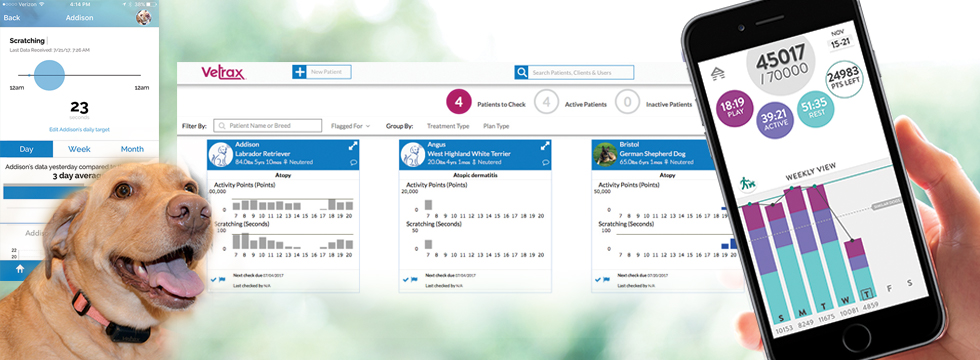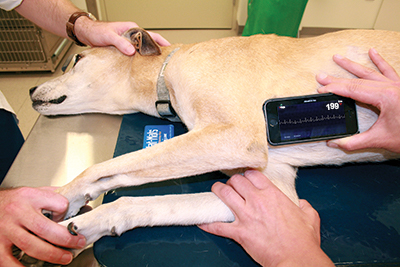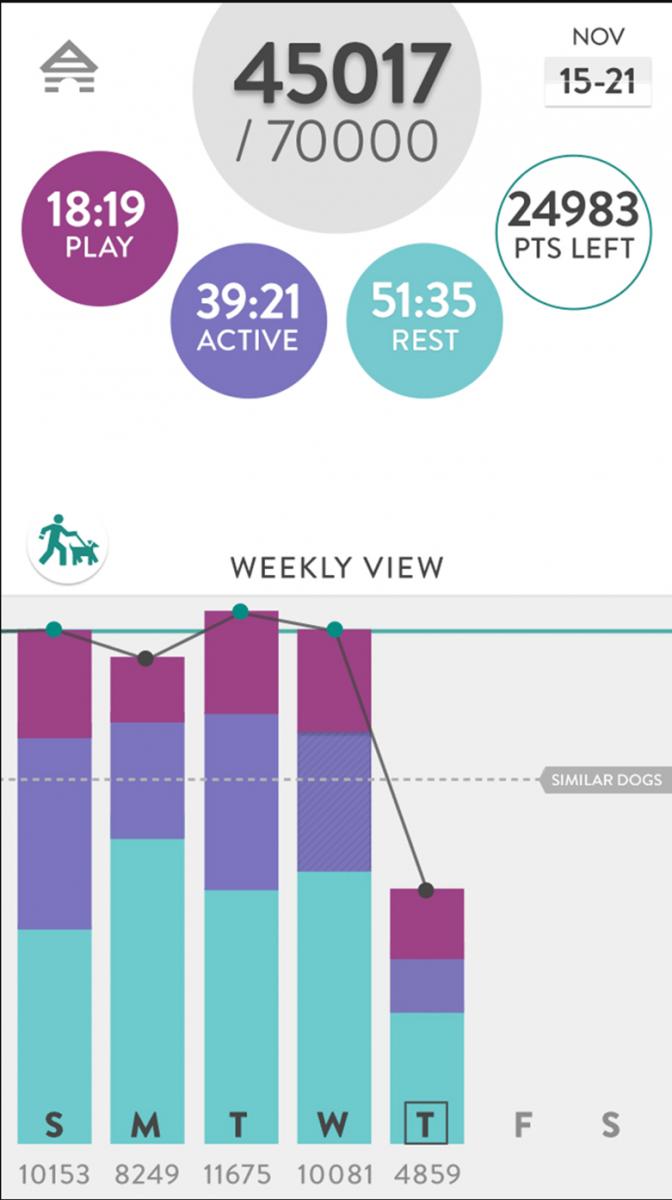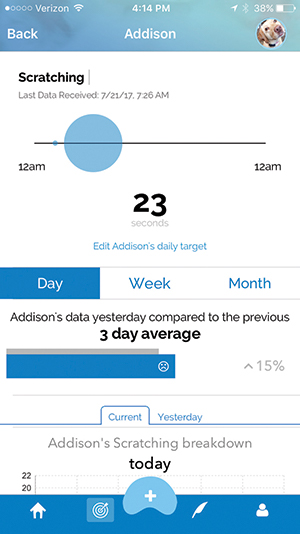


The list of innovative, and actually pretty amazing, technologies for everyday human use is impressive. With eye-popping new gadgets coming on the market so quickly, it was just a matter of time before some of that technology would make its way into the pet world.
That time has come. Cool technology has gone to the dogs, cats, and in some cases, horses!
Mobile ECG Device
Today’s smartphones can do lots of things, including taking and sending ECG recordings. At the Lloyd Veterinary Medical Center, veterinary cardiologist Dr. Jessica Ward and Dr. Brett Sponseller, equine internist, are using the AliveCor Veterinary Heart Monitor.
Basically, it’s a mobile ECG device that consists of two metal electrodes that snaps onto the back of an iPhone. Simple to use; just wet the animal’s fur with alcohol, then place the metal electrodes on either side of the heart. The device takes and records single-lead waveforms up to 30 seconds at a time.
“Our students have grown up with technology, so using some of these technologies in veterinary medicine is quite easy for them and they enjoy it,” Sponseller says. He uses the AliveCor as a teaching tool to fourth-year students. Because the heart rate of a healthy horse is much slower (26-44 BPM), than a dog whose rate is three times faster, the students can hear all four heart sounds. “It’s a great tool to teach auscultation. The student can place the device on the horse’s side and watch the ECG reading, as they listen to the horse’s heart beat with their stethoscope. This helps the students learn to correlate the heart sounds with the ECG reading.”
The equine field services clinicians are also using it for routine checks of the heart during a wellness exam. If the clinician hears an abnormality, he or she can record the reading and email it to a specialist for further review. The device is also useful for smaller companion animals.
“I use the devices clinically by sending them home with clients to record heart rate and rhythm,” Ward says. “It’s especially helpful for patients who have arrhythmias that are made worse by the stress of being in the hospital. I want to know the rate and rhythm when the pet is relaxed in its normal environment.”
In those situations, Ward provides the client with a device. The client takes recordings and emails the results to Ward who makes treatment recommendations based on those readings. Ward demonstrates the value of the mobile device with her dog, Anna. Illustration A is Anna’s ECG recording at the hospital. Illustration B is the recording at home, which was a 78 BPM difference.
Clients can rent the device for a month from the cardiology service, but many owners prefer to buy their own. Ward says that some general practice clinics that don’t have advanced ECG devices are also using the AliveCor as their sole ECG device. “They are great for assessing heart rate and rhythm, but not good for more complex/detailed measurements of ECG,” Ward said.
November 2017


Tracking & Monitoring
It’s the latest ... tracking your health data, everything from your steps and stairs, to sleep. There’s even a monitoring device for your dog to track its activity and sleep. Dr. Lionel Sebbag, assistant professor of veterinary ophthalmology, is using such a device, FitBark, on some dogs with cataracts.
Cataracts are a leading cause of blindness in dogs, says Sebbag. He explains when dogs are diagnosed with cataracts, their activity level is decreased, which can have a negative impact on the pet’s general health (e.g. increased body weight, osteoarthritis, and so forth).
“FitBark is a research-grade dog activity and sleep monitor,” Sebbag says. “It collects physical activity and rest levels 24/7, providing the veterinarian and owner with unprecedented insights into health and behavior.”
The device is placed on the dog’s collar, and is connected via Bluetooth to the owner’s personal smartphone. The FitBark app allows the owner to monitor several parameters, including play time, active time, rest time, sleep score, and an overall daily-goal score.
The goal of Dr. Sebbag’s study is to use FitBark technology to objectively assess activity level of dogs before and after cataract surgery. The research team hypothesis is that the activity level will significantly increase once vision is restored with cataract surgery.
“The study will allow us to obtain objective data to prove that restoring vision with cataract surgery is beneficial to the overall health of the dog,” Sebbag said. “This information would be greatly valuable for both veterinarians and pet owners.”
Another cool device that veterinary dermatologist Dr. Darren Berger just got his hands on for his furry-pawed patients is VetraxTM. The VetraxTM is an activity monitor with a unique capability to track scratching and head shaking through a lightweight and water-resistant sensor that attaches to the dog’s collar. Berger is currently evaluating the clinical use of the monitors.
“We often ask clients to rate their dog’s itchiness on a scale,” Berger says.
“There’s a lot of subjectiveness depending on how ‘itch-tolerant,’ the client is. With the VetraxTM itching and scratching is recorded in seconds/minutes and the data is uploaded. Through an app on my computer, I can see how many minutes a day a patient is itching and/or scratching.”
Currently, Berger is getting an idea of what the baseline threshold range might be to determine whether the patient needs treatment. For patients who need treatment, Berger sees the VetraxTM as a useful tool to evaluate the effectiveness of treatment regimens.
